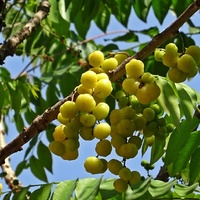Common name: Jimbling
Other common names: Cheramina, Gooseberry tree, Short jimbelin, Otaheite gooseberry, Star gooseberry
Description
The origins of this fruit-bearing tree have not been confirmed, but it is believed to have originated in Brazil. It is commonly 5 to 10 meters tall and develops either a single or multiple trunks. The bark is light-grey bark and dotted with wart-like pores. A rounded crown formed by upright branches becomes sprawling with age. Leaves are arranged opposite on long stems appearing feather-like and are semi-evergreen to deciduous. There is much uncertainty as to whether it originates from Brazil, Southeast Asia or Madagascar.
In regions with a pronounced dry season, flowering usually coincides with leaf fall at the height of the dry season. In more humid regions (with rainfall in excess of 2000 mm annually) or where trees are given water flowering is less predictable, with intermittent or continuous flowering and little or no leaf fall.
Fruit are small, round, ribbed maturing to light yellow about 3 months after flowering.
Jimbling
The tree grows on a wide range of soils but prefers rather moist sites.
Climate: Jimbling is adapted to a wide range of climates, from tropical to subtropical with air temperatures generally in the range of 10 to 35C and with annual rainfall between 1000 and 3500 mm.


